#empower students
Photo
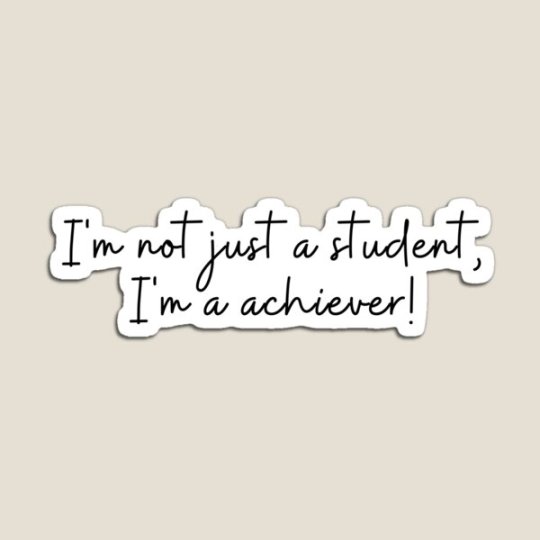
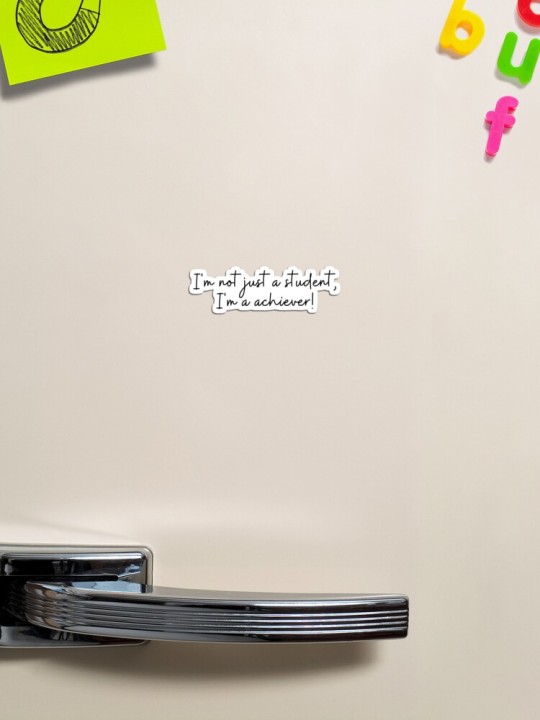





(vía "Empower Students, Motivational Stickers & Magnets, Self-motivation, Inspirational student gifts, Student encouragement" Magnet for Sale by Noemill)
Get empowered and show now!
#findyourthing#redbubble#achivement#achiever quote#get motivated#motivating quotes#motivation#student motivation#student success#student quotes#student stickers#student encouragement#student inspiration#student girl#student gift#empower students#ambitious stickers#student gift ideas#encouraging quotes#encouraging growth#encouraging decals#positive affirmations#positive quotes#positive thoughts#positive mental attitude#mindfulness#mindset#student mindset#student life#student success quotes
0 notes
Text
Fostering Creativity in Student Blogs With ChatGPT Training
Are you an educator looking to inspire creativity in your students' writing? Would you like to guide them in crafting captivating blog entries? If that's the case this piece is, for you. Let's delve into how incorporating ChatGPT can unlock your students' creative abilities and elevate their blogging endeavors. Discover how this cutting edge AI tool can revolutionize your teaching approach and ignite a wave of student ingenuity and involvement.
The Advent of ChatGPT: A Game-Changer for Student Blogs
table { font-family: arial, sans-serif; border-collapse: collapse; width: 100%; } td, th { border: 1px solid #dddddd; text-align: left; padding: 8px; } tr:nth-child(even) { background-color: #dddddd; }
ChatGPT, developed by Anthropic, is an AI-powered natural language processing (NLP) model that has captivated the world with its remarkable ability to engage in human-like conversations, answer questions, and generate coherent, well-structured text.
Imagine a student from London looking to enhance their writing skills. Traditionally, they need a mentorship of an experienced writer to start their blogging. But ChatGPT training London can provide them with personalized learning experiences tailored to their specific needs and preferences. This revolutionary technology has the potential to transform the way students approach creative writing and blog content creation. By leveraging ChatGPT Training, students can:
Enhance Creativity
ChatGPT can be a fun `writing buddy" that helps students come up with creative new ideas for their blog posts. The AI can give them suggestions when they get stuck, which can lead to more unique and imaginative writing. ChatGPT's text is a jumping-off point for students to build upon and explore.
Improve Writing Skills
By practicing with ChatGPT and getting its feedback, students can get better at writing. The AI can point out ways to improve their sentences, word choices, and how clearly they express their thoughts. As students work with ChatGPT, they'll become stronger writers who can communicate their ideas more effectively.
Streamline the Writing Process
ChatGPT can handle some of the more routine writing tasks, so students can focus on the creative parts. It can help outline blog posts, do research, and even draft initial versions. This allows students to spend their time and energy on crafting great stories and insights instead.
Boost Engagement
Using AI-generated content, students can create blog posts that are well-written and visually engaging for their audience. ChatGPT's human-like writing can be combined with other AI tools that generate images, videos and interactive elements. The end result will be a more captivating blog that really grabs readers' attention.
Content Creation and Creativity Development for Students
Content creation and creativity development are essential for students to foster a sense of ownership in their learning and prepare them for future careers. By empowering students as content creators, educators can help them develop valuable skills, increase opportunities for learning, and create engaging and personalized content.
Empower Students as Content Creators
Here are five ways to empower students as content creators:
Let students use fun presentation tools like Nearpod. They can make slideshows with videos, activities, and games to share what they learned with classmates. Working together makes learning exciting!
Encourage students to write blogs. Blogging lets them share their thoughts, opinions, and ideas through writing. It helps improve their writing skills, thinking abilities, and creativity. Plus, others can read their work online.
Students can make and edit videos using programs like iMovie, Adobe Premiere Pro, or Final Cut Pro. Making videos helps them tell good stories, be creative, and learn tech skills. They can share their video projects online too.
Using design apps like Canva, Adobe Illustrator or Procreate, students can make cool visuals that communicate ideas clearly. Graphic design develops creativity, visual communication abilities and computer talents. Their artwork can be shared widely.
Encourage students to create podcasts or audio stories using Anchor, GarageBand or Audacity. Podcasting improves storytelling abilities, creativity and tech proficiency. Their podcasts can be published for others to enjoy.
The main idea is having students create multimedia projects to build communication skills while sharing their work publicly. This makes learning interactive and motivating.
The Benefits of Creativity and Content Creation
Letting students create their own content helps them build valuable skills, have more opportunities to learn, and make engaging personalized material. Encouraging creativity and thinking in new ways also helps learners come up with fresh ideas, improve their creative-thinking abilities, and remember information for longer.
Having creativity and content creation in the learning process can even benefit entire companies and businesses. Companies that make creative thinking a priority often perform better than their competitors in revenue growth, total sales, and leadership skills.
To properly incorporate creativity and content creation into learning, educators should give students chances to analyze and understand the basic parts of a subject, organize their thoughts and ideas, communicate effectively with others, and take creative risks in a supportive personalized learning environment.
By helping students develop a love of learning and creativity, educators can make them more future-focused, engaged, and successful in their academic and professional lives.
Leveraging ChatGPT for Content Creation
Ideation and Brainstorming
ChatGPT can be a helpful brainstorming buddy, giving students unique ideas for blog topics, storylines, and new angles. The AI can make connections students might not think of and provide fresh perspectives. This can inspire students to think outside the box and find unexpected sources of inspiration.
Multimedia Content Generation
ChatGPT's writing abilities can be combined with other AI tools to create different types of multimedia content for student blogs. It can help write engaging intros, section summaries, social media captions, email newsletters and more to go along with visuals like images, videos and infographics.
Personalized Content Tailoring
By understanding what their audience likes and struggles with, students can use ChatGPT to generate highly personalized, relevant blog content. The AI can identify the most compelling topics, tones, and messaging that will resonate with specific groups of readers, ensuring their posts have maximum impact.
Content Optimization
ChatGPT can also help optimize blog content to be visible in search engines and engage readers better. The AI can suggest effective keyword usage, meta tags, and other SEO-friendly elements, so students create posts that are both compelling and discoverable.
By smoothly bringing ChatGPT into the content creation process, students can unleash new levels of creativity, audience engagement, and overall blog performance, setting themselves up for greater digital success.
Integrating ChatGPT Into the Classroom
Incorporating ChatGPT Training into the classroom setting requires a thoughtful and strategic approach. Take a look at the below chart that shows the growth of AI in education.
But still, educators must strike a balance between leveraging the technology's benefits and ensuring that students develop essential writing skills independently.
Here are some key steps to successfully integrate ChatGPT into your classroom:
Educate Students on AI and ChatGPT
Before using ChatGPT, students need to understand what it is. Explain that ChatGPT is a computer program that can understand and respond to questions using artificial intelligence (AI). Its responses are generated by analyzing lots of data, not by actually thinking like humans.
Provide Guidance and Scaffolding
Next, guide students on how to use ChatGPT properly. Show them how to ask questions and give prompts. Do activities where they edit and improve ChatGPT's responses to match their own writing voice and style. Give lots of examples and feedback.
Emphasize Critical Thinking
It's important that students don't just copy what ChatGPT says word-for-word. Encourage them to think critically about the responses. Do the answers make sense? Are they accurate and relevant to the topic? Students should view ChatGPT as a helper tool, not the final answer.
Foster Collaboration and Peer Review
Have students work together in pairs or groups. They can share their writing, provide feedback, and discuss how to use ChatGPT effectively. Collaborating helps build communication skills while using the AI responsibly.
Assess and Evaluate
Check in regularly on students' progress. See if their writing is improving and if they understand how to use ChatGPT appropriately. Ask for their opinions too. Adjust your teaching methods if needed to make sure students are truly learning, not just relying on the AI.
The key is making sure students develop their own writing abilities while leveraging ChatGPT as one tool among many. With patience and practice, they can master this new technology.
Overcoming Challenges With AI
Integrating AI into the creative content development process presents both exciting opportunities and significant challenges for businesses. AI can help people be more creative by giving them new ideas or content to build upon. It can generate material that really connects with the audience in powerful ways. AI assistance can make it easier to achieve marketing goals.
Ethical Considerations and Unintended Biases
There are ethical concerns about AI that businesses must address. Some worry AI could violate people's privacy, be biased against certain groups, or spread incorrect information. Companies need to ensure their AI-made content is high-quality, original, and ethical.
Balancing AI Assistance and Independent Skill Development
Another challenge is striking the right balance. It's important for the creative team to still develop their own skills and ideas, rather than depending too much on AI assistance. Over-relying on AI could limit true human creativity and innovation.
Overcoming Implementation Hurdles
Finally, properly using AI tools and integrating them into existing work processes is difficult. Businesses have to spend time learning the AI technology, figuring out how to instruct it effectively, and blending the AI's output with human-made content smoothly. If not done carefully, a lot of time and money could be wasted on subpar AI-generated content.
Although AI presents exciting creative opportunities, businesses must thoughtfully navigate the ethical risks, balance AI assistance appropriately, and overcome the real practical hurdles of implementation. With diligence, AI can be a powerful tool - but not a complete substitute for human ingenuity.
Strategies for Successful AI-Powered Content Creation
To overcome these challenges, businesses should adopt a thoughtful, strategic approach to AI integration. This includes:ChatGPT vs. Traditional Writing Approaches
Establishing Clear Goals and Boundaries
As the teacher, you should decide exactly how you want students to use ChatGPT when creating content. Think about the specific jobs you want the AI to do - like giving ideas, drafting, writing, or improving students' work.
Once you know the goals, work with students to set some clear rules about using ChatGPT properly and responsibly. This ensures everyone understands the boundaries.
Providing Human Oversight and Validation
Even though ChatGPT writes like a human, you still need to have students review, edit, and approve the AI's work themselves. Have them share what ChatGPT produced and get feedback from you or classmates to improve it.
This extra human checking will help make sure the final content is authentic and high-quality. Remember, ChatGPT should complement students' skills, not completely replace them.
Continuous Learning and Adaptation
AI technology like ChatGPT keeps evolving quickly. So you and your students need to stay informed about the latest updates and changes. Spend time researching new ChatGPT abilities, learning about limitations or concerns, and adjusting how you use it accordingly.
Be open to trying new techniques as the technology progresses. Having a flexible, learning-focused mindset will really help as you navigate this exciting but constantly shifting landscape.
Emphasizing Collaboration and Skill Development
The most important thing is to create a classroom environment where students collaborate and keep developing their own creative abilities. Encourage them to work together, share ideas, and provide helpful feedback to each other. Use ChatGPT as a supportive tool, but make sure students are still flexing their own creative muscles. Striking this balance will ensure they gain valuable hands-on experience that will help them, both in the classroom and in the future.
If businesses embrace the opportunities AI provides while properly addressing the challenges, they can unlock a new era of creative content that truly connects with their audience and drives meaningful results.
The Future of Student Blogging With ChatGPT
As we embrace the transformative power of ChatGPT Training, the future of student blogging holds immense promise. By seamlessly integrating this AI technology into the educational landscape, we can empower students to:
● Develop Unique Writing Styles: ChatGPT offers students the opportunity to nurture their voice in writing enabling them to express their thoughts and perspectives uniquely.
● Explore a Variety of Subjects: Utilizing ChatGPT allows students to dive into topics broadening their understanding and sharing their viewpoints with an audience.
● Increase Reader Engagement: AI generated blog content can captivate readers with narratives stimulating ideas and visually appealing presentations.
● Get Ready for Tomorrow: Through ChatGPT Training students can acquire skills in creating content, digital literacy and adapting to technology.
ChatGPT vs. Traditional Writing Approaches
table { font-family: arial, sans-serif; border-collapse: collapse; width: 100%; } td, th { border: 1px solid #dddddd; text-align: left; padding: 8px; } tr:nth-child(even) { background-color: #dddddd; }
Feature Traditional Writing Approaches ChatGPT-Powered Writing Creativity Reliance on individual ideas and inspiration Assistance in generating unique and innovative ideas Writing Efficiency Slower process, more time-consuming Streamlined writing process, with AI-powered assistance Feedback and Revision Dependent on teacher or peer review Ability to generate multiple drafts and receive real-time feedback Engagement Potential for less engaging content Increased engagement through AI-generated visuals and storytelling Skill Development Focused on individual writing skill development Complementary approach that enhances writing skills while leveraging AI technology
Key Takeaways
● ChatGPT can be a really helpful tool for student blogging, allowing them to boost creativity, improve writing abilities, make the writing process smoother, and create posts that better engage their audience.
● To use ChatGPT in the classroom successfully, teachers need a well-thought-out plan that takes advantage of the technology's benefits while still helping students develop strong independent writing skills.
● Educators should focus on teaching students about AI and ChatGPT, providing guidance and support, emphasizing critical thinking, encouraging collaboration, and regularly checking if the integration is working effectively.
● To overcome challenges of using AI for creative content, it's important to set clear goals and rules, have humans review and approve the AI's work, continuously learn and adapt as the technology changes, and emphasize collaboration and skill development.
● The future of student blogging with ChatGPT looks very promising, as students can develop unique voices, explore diverse topics, better engage their audience, and prepare for 21st-century career demands.
● By carefully integrating ChatGPT and guiding students to use it responsibly, teachers can unlock new levels of creativity, engagement, and learning through student blogs.
Unleashing Student Creativity with ChatGPT
Using ChatGPT can enhance students' creativity. Make their writing more engaging. However it's crucial for teachers to provide guidance on its use. Students need to evaluate the suggestions from ChatGPT to nurture their creativity and cultivate their voices.
This approach helps prepare students for what lies and enhances their journey. Let's collaborate to leverage ChatGPT for the benefit of student creativity and development.
Frequently Asked Questions (FAQs)
1. How can ChatGPT help me with my student blog?
ChatGPT can assist you in various ways, such as generating ideas, drafting content, and improving your writing style. It can also help you create more engaging and visually appealing blog posts.
2. Is it ethical to use ChatGPT for my student blog?
Using ChatGPT can be ethical as long as you use it responsibly and transparently. Be sure to acknowledge the AI's contributions and encourage critical thinking and independent writing.
3. How can I ensure that my writing remains unique and authentic when using ChatGPT?
The key is to use ChatGPT as a tool to enhance your writing, not to replace it entirely. Maintain your unique voice and perspective, and use the AI's capabilities to refine and expand your ideas.
4. What are the limitations of using ChatGPT for student blogging?
While ChatGPT is a powerful tool, it still has limitations. It may not fully understand the context or nuance of your specific topic, and its outputs may not always be accurate or up-to-date.
5. How can I incorporate ChatGPT training into my curriculum?
Consider offering workshops, tutorials, or guided activities that teach students how to use ChatGPT effectively and ethically. Integrate the technology into your lesson plans and provide ongoing support and feedback.
6. What are some best practices for using ChatGPT in student blogs?
Establish clear guidelines for using ChatGPT, such as acknowledging its contributions, encouraging critical thinking, and ensuring that the final content is a reflection of the student's own ideas and writing
Daniel Martin
Dan has had hands-on experience in digital marketing since 2007. He has been building teams and coaching others to foster innovation and solve real-time problems. In his previous work experiences, he has developed expertise in digital marketing, e-commerce, and social media. When he's not working, Dan enjoys photography and traveling.
LinkedIn Profile
Pin or save this post for later!
Share in the comments below: Questions go here
#creativity#content creation#chatGPT#Student blog#student productivity#writing skills#writing process#boost engagement#empower students#benefits of creativity#student blogging
0 notes
Text

𝐈𝐧𝐬𝐩𝐢𝐫𝐢𝐧𝐠 𝐌𝐢𝐧𝐝𝐬, 𝐒𝐡𝐚𝐩𝐢𝐧𝐠 𝐅𝐮𝐭𝐮𝐫𝐞𝐬 & 𝐄𝐦𝐩𝐨𝐰𝐞𝐫𝐢𝐧𝐠 𝐓𝐨𝐦𝐨𝐫𝐫𝐨𝐰'𝐬 𝐋𝐞𝐚𝐝𝐞𝐫𝐬!
On this Teacher's Day, let's celebrate the heroes who ignite our minds and shape our dreams. Thank you, teachers, for being our guiding light on this incredible journey of learning and discovery!
Warm Greetings,
Waves Institute of Fashion Designing
#teachers day#gratitute#education#inspiration#thank a teacher#learning journey#mentors#guiding light#empower students#wifd#fashion institute#kozhikode#calicut
0 notes
Text
Incredible Ways to Empower Students During eLearning
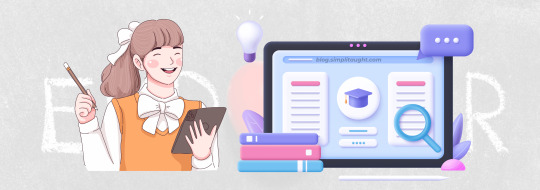
With the arrival of eLearning on the education scene, instructors redesigned their courses and lessons to accommodate students' needs. Also, the students learned how to connect from the likes of their bedrooms, kitchens, or back porches.
However, there are many barriers to remote learning and empowering education than a well-planned lesson. Usually, many learners don’t have access to reliable technology or stable internet. Others don’t have access to adults to help them understand learning materials at home. In addition, learning management systems (LMS) overwhelm students.
Hence, this has left many students feeling like losing control of their education and sometimes their entire world.
7 ways to empower students in online learning
So the question arises, what the stakeholders in online learning can do to empower students? Here are a few incredible ways to empower students in the education process to let them excel at their studies.
1. Let them explore
Remember the times when you walked down the toy aisle as a child? What was the first thing you did back then? Magical toys were lining the shelves with a “try me” button ingrained in them. So, of course, you went to the toy and began playing with it. You not only touched that button but also explored many other features of the toy. You understood that feature and told your parents to convince them to buy it for you.
The same goes for the technologies and learning management systems we use in remote education. We fear and are hesitant with technology we often think students will break things if they try them.
2. Let them teach
Students tend to learn better and be intuitive when it comes to technology. So, they excel when dealing with tools rather than lessons or academic content. So, let learners teach each other how to do things, share the features they have found, and discuss and problem-solve together.
It will amazingly empower students to do the teaching and motivate peers to try out things and ask questions. Make a “Check With a Classmate” policy, and when a student struggles with something, create a plan of how they can reach out to each other for help instead of asking teachers first.
3. Teaching experts
As instructors, we are usually used to being the ones to do the teaching. However, you must be ready to lose control and let students be the ones who know the most. For example, let them teach you different features of LMS or web conferencing tools.
They will figure out a way to enlarge something or submit their assignments differently. So, as an educator, you should take time to let them share and learn different concepts from them.
4. Project-Based learning
Allow students to do project-based activities and encourage them to do real-life learning.
Learners are not in classrooms; they are in their own environments. They know best what materials they have to work with. They also have creative ideas to use them. Therefore, give open-ended tasks and let them choose how to demonstrate their learning.
For instance, if you are studying a novel in your virtual classroom, ask students to bake something from a recipe a character shares, dress up like one of the characters, prepare a skit with their siblings, or use online tools at their disposal to make a funky poster. This will help them creatively express themselves.
5. DIY Educational Environment
In traditional classrooms, it’s challenging to let students customize their browser window, their desk space, and more. Now that they are at home, encourage them to create their own digital and physical learning space that suits them. Going forward, have a look at the online learning pros and cons.
From an assistive technology viewpoint, aid students in searching for browser tools that work best for them. For example, screen enlargement, font choices, alternate seating, scream brightness, standing with your computer at a counter, etc.
6. Accept Students as Whole
Pupils leave their homes every day to attend classes. Likewise, during online distance learning, they leave “home at home” to be present in virtual classrooms.
In elementary schools, educators encourage students to bring pictures or make posters during their “student of the week” turn.
And as they get older, students are asked to focus on school. However, it’s impossible in an online learning environment.
7. Teach them Grace!
Set schedules of classes and learning periods are no longer applicable. Many students are expected to help at home, watch over their siblings, deal with distractions, and do work outside the home.
Empower students in making decisions about their schedule and time. Also, teach grace to students who get overwhelmed or fall behind.
Let them realize that learning and their real-life situations can go hand-in-hand, but sometimes they need to adjust their schedules. They also need to know the higher education’s reshaping factors due to online learning so that they can plan accordingly.
Let students know they can also fall behind and miss deadlines. However, show them the importance of making a plan to fix things and move forward rather than giving up.
0 notes
Text
*tries to organize my thoughts*
*remembers i'm not in school and therefore beholden to neither heaven nor hell nor any man's grading system*
*joyously shredding & tossing all my carefully arranged 3x5 mental notecards into the air like so much beige confetti. raising my arms in victory, cheering raucously until i accidentally inhale bits of homemade confetti*
(*coughing up itty bits of paper like a cat evicting a hairball with a firm understanding of tenants' rights*) wait wat happens next
#i marie kondoed my thoughts and *i* feel great. but now my stream-of-consciousness has escaped containment#so many innocent bystanders at stake#every time i try to organize my thoughts i run out of plastic bins and have to make a trip to the container store where i get even more dis#racted so. you can't just hand me THIS brain and NO catalogue OR library classification system#and expect me to single-handedly sort through all this nonsense? bad form but fucking form not in my job description#aNYways. formal education sure did a FUCKING NUMBER on us huh#(a number i measure not in gpa or dollars of student debt.#but in the number of therapy sessions & medical debt it will take to recover.)#seriously folks. our education systems are...innately traumatizing for a huge number of students. and we NEED to address this.#the fact that it is culturally common for adults to have anxiety nightmares about school/exams...even decades later?#that is not cute. it is Alarming.#no one--much less entire generations--should be spending their developmental years in an environment of chronic stress & pressure & strain#and yet that is the reality for millions and millions of pre-teen and teenage and young adult students#this isn't healthy and it serves and empowers NO ONE#...except of course the many exploitative educational & financial & debt-collecting institutions thriving from the current balance of power#and of course it's a nefarious and powerful way to sabotage/erase the middle class#which billionaires and the wealth-inequality creators they finance couldn't possibly have any noteworthy interest in whatsoever#it's not like there's an elite group of people with huge financial incentives to drain/steal resources from the masses...#anyways sorry for going all Conspiracy Theory on you.#obviously the billionaires who control the vast majority of our resources and news and political campaign funding#are not tied to every single itty bitty social issue and i'm a silly billy to imply it#please tell elon musk to ignore this tweet i am so subservient and acquiescent#mr musky u r so good at inheriting slavery-built mining fortunes & buying other people's companies#& building rocket ships & fancy cars that do NOT explode/catch fire & also NOT running billion dollar companies into the ground#mr musky u r so talented genius billionaire playboy with 10 kids and ex-wives who find you creepy af babe u r basically iron man
2K notes
·
View notes
Text
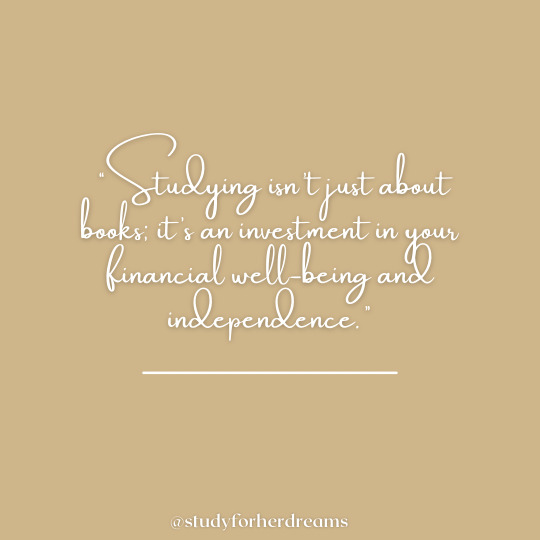
“Studying isn’t just about books; it’s an investment in your financial well-being and independence.” - unknown
#study aesthetic#study blog#study motivation#studyblr#studying#study#studyspo#inspirational quotes#student#study with me#women empowering woman#academia quotes#academia#revision#revising#studyinspo#studybrl#studywithme
22 notes
·
View notes
Text
Doing an Early Church study and they casually hit us with “the ten thousand martyrs [from a single city/location]” and “So many were killed on a single day that the axe, blunted and worn out by the slaughter, was broken in pieces, while the exhausted executioners had to be periodically relieved.”
Then you look it up and learn that, yes, the martyrdom of ten thousand people in Nicomedia is supported by historical documents and they can actually specify it likely happened in the year 303 A.D. under the beginning of Diocletian’s reign.
Historians estimate that between 250 and 311 A.D, 60,000 Catholics were martyred. That’s around 1,000 a year, or three a day, for SIXTY YEARS.
“✨We are the granddaughters of the witches you couldn’t burn.✨” Oh yeah? Well we’re the descendants of the Catholics you couldn’t kill. Of people who stood firm in the face of horrors beyond comprehension, who knew that hours or days of pain was nothing compared to the ecstasy that awaited them. I pray that I can have a fraction of their courage and dignity, a hint of their resolve and charity.
Holy martyrs, pray for us.
#catholic#catholicism#christianity#religion#catholic nerdstuff#martyrs#martyrdom#“Why are you Catholic?”#Because only one Church has endured for over 2000 years#Only one Church can trace their roots directly back to the apostles in an unbroken line of succession#Only one Church can look at documents written around 100 A.D. by students of the apostles themselves and say#‘Yes. This is what we teach and have taught from the very beginning’#Because only a Church that offers truth could’ve survived such horrific persecution when it had barely left infancy#Because it is only empowered by God that 100s of 1000s of men women and children could face persecution torture and death without flinching
9 notes
·
View notes
Text
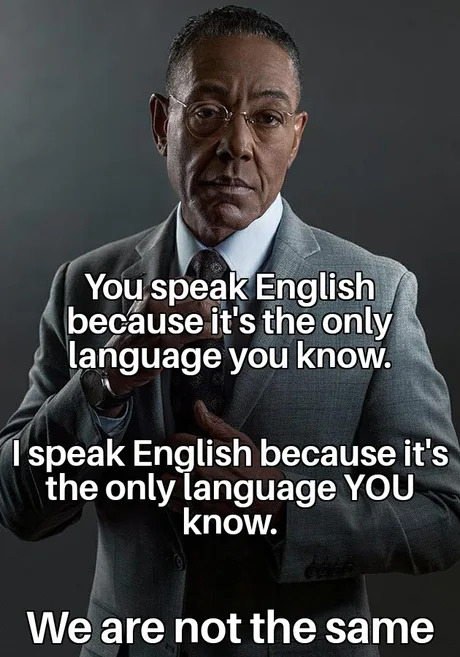
Thought every insecure non-native English speaker should see this.
41 notes
·
View notes
Text
The Rewarding Role of an Educational Assistant
Shaina Tranquilino
February 2, 2024
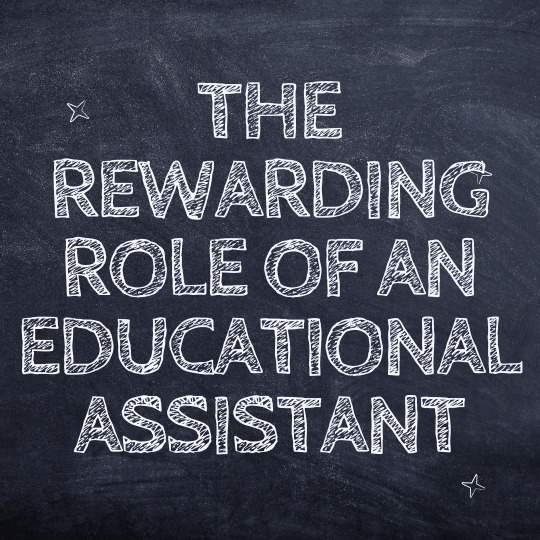
Education is the key to unlocking a child's potential and setting the foundation for their future success. While teachers play a vital role in shaping young minds, educational assistants are unsung heroes who work tirelessly behind the scenes, providing invaluable support to both students and educators alike. In this blog post, we delve into why being an educational assistant is such a rewarding profession.
1. Making a Difference in Students' Lives:
As an educational assistant, you have the opportunity to directly impact students' lives on a daily basis. Whether it is working with students who have special needs or those requiring extra support, your presence can make all the difference in helping them overcome challenges and achieve academic success. Witnessing their growth and progress firsthand is immensely fulfilling.
2. Building Strong Relationships:
Educational assistants often work closely with individual students or small groups, allowing for more personalized attention and fostering strong relationships. This close connection enables assistants to understand each student's unique learning style, strengths, weaknesses, and interests. By building rapport, trust, and understanding, educational assistants can not only provide academic assistance but also serve as mentors and confidants.
3. Collaborating with Teachers:
Collaboration is at the heart of successful education environments. As an educational assistant, you work alongside teachers to develop lesson plans, create engaging activities, and implement strategies tailored to meet each student's needs effectively. This collaborative approach ensures that students receive comprehensive support while gaining insights from experienced professionals.
4. Constant Learning Opportunities:
Being an educational assistant exposes you to various teaching methodologies and diverse classroom settings. You learn about different learning styles and adapt your approach accordingly to accommodate every student's requirements effectively. Additionally, you gain valuable knowledge about specific subjects or areas of expertise through continued professional development opportunities offered by schools or districts.
5. Job Satisfaction:
Few things can compare to the sense of fulfillment derived from knowing that you have made a positive impact on the lives of students. Whether it's witnessing a struggling student finally grasp a difficult concept or seeing their confidence soar as they conquer challenges, these moments bring immense joy and job satisfaction. The gratitude expressed by both students and their families further reinforces the value of your contributions.
6. Career Growth and Opportunities:
The role of an educational assistant can serve as a stepping stone to various career paths within the education sector. With experience, you may choose to pursue further education or certifications to become a teacher, special education coordinator, or even move into administrative roles. The skills and knowledge gained as an educational assistant provide a solid foundation for long-term professional growth.
Being an educational assistant is not just another job; it is a rewarding profession filled with meaningful experiences. From impacting students' lives and building strong relationships to collaborating with educators and constantly learning, this role offers personal fulfillment and opportunities for growth. If you have a passion for helping others learn and grow, being an educational assistant could be the perfect path for you!
#educational assistant journey#educational assistant#supporting students#empowering education#teamwork in education#learning partnership#impactful teaching#student success#classroom collaboration#educational support#inspiring learning
3 notes
·
View notes
Text
SNORK FUCKING MIMIMI
#my day started at 11AM. ELEVEN. AM. let that sink in. and has just now ended at 3am. (three in the morning. am. 3am. three am.)#i am SLEEPY i cant feel MY LEGS#like we all got ready at 11am. we went to spoons breakfast. we pre'd until like 2/3#AND THEN WE WENT TO THE HORSE RACES! BC THERE WAS A STUDENT DAY THING! IT WAS SO FUN! MUCH BETTER THAN LAST TIME!#and we were there until like? 9? i think?#and then we come home to get our shit together. had a chinese. drank some more. and then we went to the club#and we stayed until close bc when i TELL YOU the dj did not play a single skip song#it was just banger after banger i think ive lost my voice#but oh my god my POOR LITTLE LEGS#I WAS IN HEELS THE ENTIRE TIME I WAS AT THE RACES#6/7 HOURS IN HEELS JUST TO TAKE THEM OFF TO GO CLUBBING??? OW#IM GOD'S STRONGEST SOLDIER TBFH#ALL THAT WAITRESSING DID ME GOOD APPARENTLY MY FEET ARE STRONGER THAN SISYPHUS ON THEIR OWN#FUCK THAT ROCK BOY#ow. ow ow ow. but it was such a good day so idc. i met a guyyyyy <3#i also fucking body checked this one girl and i feel a bit bad bc she was so clearly having her teen coming of age moment in the club#like white girl dancing hands over her head twirling etc. unfortunately for her AND ME that involved bumping into me repeatedly#and like? she kept turning to us to try make us dance with her but me and my mates were having a lot of fun in our little trio so we didn't#which yeah maybe that was mean but tbh if someone did that to me id take no for an answer the first time instead of repeatedly doing it#like she was acting like she was empowering us and freeing us from the shackles of insecurity when rlly we were just like girl no#and she WOULD NOT GET THE FUCK OFF ME like zero spacial awareness to her#the irony of clubs is like yeah obvs ur surrounded by people but it's also looked down upon if ur seriously in someone's space#so i just wasn't having it and in the end i just fully fucking SHOVED her off lmfaoooo. sorry girlie <3#like i felt embarassed for her bc of it like she was so in her own little world and i absolutely ruined it but idc#be aware of other people and their comfort bitch!#anyway yeah it was very fun all in all <3#hella goes to uni
15 notes
·
View notes
Photo



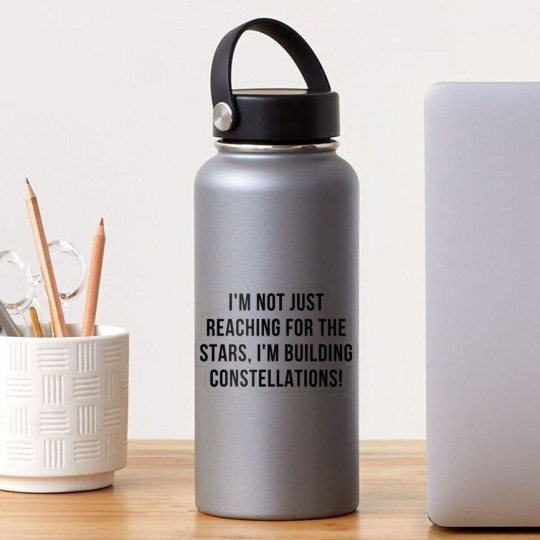

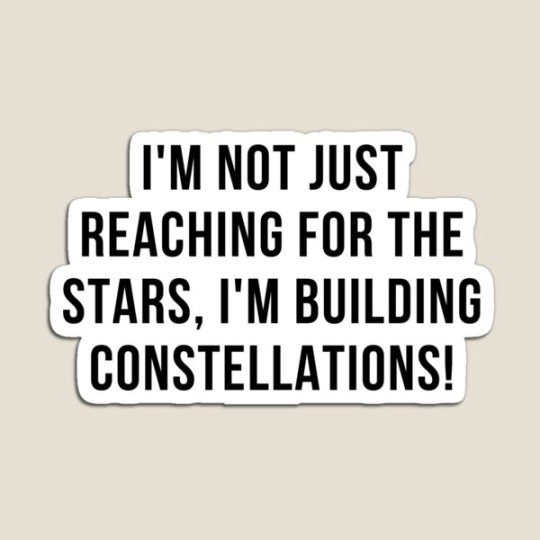
(vía "Inspirational quotes, Student gifts, Gift for her, Ambition reminder, Positive affirmations, Academic motivation, Growth mindset" Magnet for Sale by Noemill)
Get yours today!
#findyourthing#redbubble#academic motivation#growth mindset#ambition reminder#inspiration#inspiring quotes#inspirational quotes#motivating quotes#motivational quotes#student gifts#gift for her#gift for him#positive quotes#positive thoughts#positive mental attitude#positive affirmations#student motivation#student inspiration#personal development#empowering messages#motivational stickers#student success#student mindset#reaching the star#gift ideas#unique gifts#student encouragement#student aesthetic
3 notes
·
View notes
Note
birdcage why is college so expensive. sorry this is weird ask i am going SICKO mode right now
my friend i wish i knew. i do not know what country you are coming to me from but here in the united states of hell, i feel only rage when i think about how university is free in some countries. like rn in graduate horror funhouse college, i just paid for a semester where the line items for cost were "credits" + "fees". tf am i paying for here. give me a line item breakdown. tell me exactly where my money is going so i feel empowered as a student!!
i am sorry you are in the thick of it, you have my greatest sympathies. if you have to take out federal student aid, my main recommendation is whenever you have to call their customer service line to get some nonsense bullshit sorted out, be really careful about what you dial bc one time i misdialed my student loan servicer by one number and ended up on the phone with a sex line call center. the psychic damage i took was immense. "hey handsome thank you for calling [name of the sex line call center i forgot what it was], are you touching yourself? would you like to be?" "this is not my federal student aid loan service customer help line......is it??" and it wasn't.
#no but you are so valid for being mad. go get that college degree and then tear down the system that made you pay for it#imho state and community colleges and trade schools should be 100% free and paid for by the government#and private colleges should be empowered to assist as many first gen students and low income students as possible#and my hottest take? every school - EVERY SCHOOL - should provide ample subsidized housing for at least 1/3-1/2 of all students#including designated subsidized and/or free housing for returning students and adult students with families of multiple kids#that's a rant for another day lmao#anyway i am so sorry you are in sicko mode!! stunt on those hoes#cage replies#anon
6 notes
·
View notes
Text
Why I Chose STEM: A Journey into Science, Technology, Engineering, and Mathematics"
Introduction
Choosing a career path can be a daunting and life-altering decision. It often requires careful consideration of your interests, skills, and long-term goals. For me, the choice was clear: I decided to pursue a career in STEM (Science, Technology, Engineering, and Mathematics). In this blog, I will share the compelling reasons why I chose STEM and how this decision has impacted my life and the world around me.
1. A World of Endless Possibilities
One of the most enticing aspects of STEM is the sheer breadth and depth of possibilities it offers. STEM fields are at the forefront of innovation and are constantly evolving. Whether you're passionate about space exploration, medical breakthroughs, cutting-edge technology, or sustainable engineering, STEM provides a platform to explore and contribute to these fields. The opportunity to make a meaningful impact on the world through discovery and innovation is a compelling reason to choose STEM.
2. Problem Solving and Critical Thinking
STEM education equips individuals with strong problem-solving and critical-thinking skills. In a world where complex issues and challenges abound, the ability to analyze problems and develop effective solutions is invaluable. STEM encourages a systematic and logical approach to addressing problems, a skill set that is transferable to various aspects of life.
3. An Ever-Growing Job Market
STEM careers are consistently in high demand. As the world becomes increasingly technology-driven, the need for individuals with expertise in science, technology, engineering, and mathematics continues to grow. Job security is an attractive feature of STEM, as it often leads to a wide range of career opportunities and competitive salaries.
4. Making a Difference
Many people choose STEM because they have a deep desire to make a positive impact on the world. STEM professionals have the opportunity to work on projects that address global issues such as climate change, healthcare, clean energy, and more. Knowing that your work can directly contribute to improving the quality of life for people all around the world is a source of great motivation and satisfaction.
5. Lifelong Learning
STEM is not just a career; it's a lifelong journey of learning and exploration. In these fields, you're constantly exposed to new information and technologies. This environment of continuous learning ensures that you stay intellectually engaged and challenged throughout your career.
6. Collaboration and Innovation
STEM often involves working as part of a team to tackle complex problems. The collaborative nature of STEM fosters innovation, creativity, and a supportive community of like-minded individuals. This camaraderie is essential in pushing the boundaries of what's possible.
Conclusion
Choosing a career in STEM is a decision I've never regretted. The boundless opportunities for exploration, the ability to address global challenges, and the gratification of making a difference in the world have been immensely fulfilling. STEM isn't just a career; it's a way of life that encourages lifelong learning, critical thinking, and collaboration. If you're considering a career in STEM, I encourage you to explore your interests, find your passion, and embark on a journey of endless possibilities and personal growth. In the end, choosing STEM might just be one of the most rewarding decisions you'll ever make.
2 notes
·
View notes
Text
What happened in archaeology during the 20th century? - Part 2
As mentioned in the previous article, during the time before 1960 in the 20th century, the focus was on methodological improvements in archaeology. From 1960 on, the focus was on theoretical improvements in archaeology. This does not mean that the 1960s marked a clear line between methodological and theoretical development in archaeology. This means the majority of events and concerns in the discipline were slightly different before and after 1960.
What happened in archaeology after 1960s?
From 1960 on, archaeology transformed into a new version of itself. We refer to it as “New Archaeology”. So, the birth of new archaeology is the main thing that happened in archaeology after 1960.
What is New Archaeology?
In new archaeology, the main focus is on studying the cultural processes of past human societies. As you may remember, in the background era of archaeology, the focus was to discover the legendary cities of the past. In the Renaissance era, the focus was to collect antiquities and study the history of antiquity. Then, in the 19th century, the focus was on studying the history of humans and their culture. Again, in the 20th century before 1960, the focus was the same. Then, only after 1960, scholars started to study how human cultures were born, evolved, and changed.
In simple words, before this new archaeology, what archaeologists studied were random and independent events in the past related to humans. But with new archaeology, they studied how those events in history connected with each other. They studied how both intentional and accidental acts of human ancestors have shaped their culture. How did the things that past humans did as well as the things that happened to past humans shape the cultures of past humans? They examined. So, as archaeologists focused on this process of birth and evolution of cultures, we call this processual archaeology.
Read full article on New Archaeology: Processual Archaeology at kamalsjournal.com
Other than the birth of New Archaeology, there were a few important events and trends that occurred after the 1960s, as listed below:
Scholars like Lewis Binford introduced new theories that resulted the emergence of new archaeology
Gordon Childe had introduced his theory of the Neolithic Revolution, explaining how human ancestors domesticated animals and plants. He said that after the domestication of animals and plants, establishing settlements and making pottery took place in order. Archaeology became the scientific discipline to test these theories.
The extensive use of technology to analyse and interpret data
Studies transformed into problem-oriented studies. Scholars began to conduct studies to find answers to research questions.
The studies focused on providing more rational conclusions than ever.
Archaeologists introduced Rescue archaeology, or salvage archaeology, to save archaeological monuments and sites as warfare and development projects were causing huge destruction to them Soon, Archaeological Impact assessments became a necessity before development projects.
In 1970, scholars introduced cultural resource management to protect valuable archaeological sites and monuments. Then, they introduced archaeological heritage management and cultural heritage management too.
So, the new archaeology is an upgrade of archaeology that emerged in the 1960s with better theories and methods, focusing on studying the cultural processes of the human past through material data.
What Happened in Archaeology After 1980?
After 1980, the new archaeology was questioned, and a new version emerged, named post-processual archaeology. Scholars like Ian Hodder introduced new theories for archaeology. This age was literally a period of theoretical reform in archaeology. In order to understand archaeology in this age, the characteristics of new archaeology and post-processual archaeology can be compared.
The new archaeology focused on quantitative results. Post-processual archaeology focused on qualitative results.
The new archaeology was pessimistic. Post-processual archaeology was optimistic. In new archaeology, it was believed that past human cultures were never able to be reconstructed with the limited data found in archaeology. In post-processual archaeology, the approach was optimistic regarding the matter.
New archaeology focused on the processes that were behind creating antiquities. Post-processual archaeology focuses on the culture behind antiquities.
The new archaeology focused on explaining past landscapes as cultural processes. Post-processual archaeology focuses on cultural or cognitive aspects of past human beings.
New archaeology considered that past incidents happened that way because of external factors such as environmental conditions, and things only changed when the environment changed. But post-processual archaeology considers the choices made by humans in the formation of history.
New archaeology looked into the past from the same point of view as we look into the present. But post-processual archaeology looked at the past from different perspectives.
New archaeology tried to understand the past as patterns of social, economic, and political anomalies, but post-processual archaeology tries to understand the past as a collection of individual anomalies. As an example, in new archaeology, it will be said that the Stone Age is followed by the Bronze Age, and the Bronze Age is followed by the Iron Age as a pattern, with some minor exceptions, due to the nature of the impact from the environment. But, in post-processual archaeology, it will be specific with the place and time where and when the Stone Age was followed by which, either bronze, copper, or iron, considering the individuality of incidents and trends that occurred in the history of mankind due to the cognition of mankind, not the environment.
Read full article on Post-Processual Archaeology at kamalsjournal.com
Summary
As discussed above, the discipline of archaeology, which had already emerged in the 19th century, was developed further as a science in the 20th century. In the first six decades of the 20th century, the use of technology extensively developed archaeology as a science in practical ways, such as chemical dating methods.
Then, in the 1960s, the theoretical evolution of archaeology took place. Rather than explaining the story behind antiquities, the past human cultural process was studied with the use of antiquities, marking the first origin of the form of archaeology we have today, which is ‘studying through material data’. And also, archaeological heritage management was introduced to have standards for dealing with archaeologically important heritage.
Then, in the 1980s, with post-processual archaeology, the approach to archaeological studies changed. Earlier, mankind’s cognition was neglected when recreating the past through material remains. There, the environment was considered the force of evolution. Simply put, it said that human culture had changed due to environmental changes. But, in post-processual archaeology, it was said that human culture changed mainly due to the intelligence humans had. As humans, we could choose whatever we wanted with our intelligence. Further, it emphasised that the past is not a pattern but a collection of various occurrences that happened at various times and in various places individually.
As of today, the archaeology we refer to is this post-processual archaeology. So, this is the long process of the origin of archaeology. However, there is an ongoing, never-ending debate about processual archaeology vs. post-processual archaeology.
At this point, if you read all seven articles, I am sure you probably get the same image in your head as I do when I hear “History of Archaeology”. And now, most probably, you have your own idea of the origin of archaeology too.
#archaeoblr#archaeology#archaeologist#archaeology for all#archaeology student#origin of archaeology#history of archaeology#20th century archaeology#archaeology in the 20th century#archaeology in the 60s#archaeology in the 80s#new archaeology#processual archaeology#post-processual archaeology#kamalsjournal#chanakakamal#empowering curiosity#inspiring understanding#sharing knowledge#academic blog
2 notes
·
View notes
Text

“Some women choose to follow men, and some women choose to follow their dreams. If you're wondering which way to go, remember that your career will never wake up and tell you that it doesn't love you anymore.” - unknown
Credit: @studyforherdreams
#study#study with me#study motivation#studyspo#studying#studyblr#study aesthetic#study blog#student#women empowering woman#dreams#financial freedom#academia aesthetic#academia quotes#academia
17 notes
·
View notes
Text
not to be a luddite on main but I genuinely don't understand why everyone is frothing at the mouth to put ai in everything now. like...what does it make better?
#lets run through the list as far as im aware of it:#it writes papers for students (not good)#it makes cheap pop art and devalues actual artists (not good)#it creates/facilitates deepfake videos which are at best gaslighty and at worst heinously unethical (not good)#it empowers content algorithms that are ALREADY a net bad and dont need any help getting worse (not good)#why are we doing this#what is the benefit#its like ppl read every scifi book about the dangers of ai and then said#what if we do that but make it mundane and stupid instead that would be better right#no not really
4 notes
·
View notes